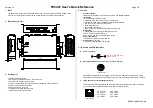
268882-UIM-A-0407
Unitary Products Group
9
Gas piping may be connected from either side of the furnace using any
of the gas pipe entry knockouts on both sides of the furnace. Refer to
Figure 5 dimensions.
PROPANE (LP) CONVERSION PROCEDURE
1.
Shut off gas supply at valve upstream from furnace or at meter as
required.
2.
Disconnect gas supply piping from gas valve on furnace.
3.
Disconnect electrical wires from gas valve, noting which wires are
connected to which terminals
4.
Remove the screws that attach the gas manifold to the burner sup-
port box.
5.
Remove and discard natural gas orifices.
6.
Remove LP (propane) orifices from the bag in the Customer
Packet.
7.
Install the LP (propane) gas orifices supplied with the furnace.
Tighten to 15 - 25 inch - pounds of torque.
8.
Reinstall the manifold in the assembly by reversing the removal
process.
9.
Reconnect the wires to the proper terminals on the gas valve.
10. Unscrew the gas valve regulator with the blue cap and turn it
upside down so the letters “LP” are upright. Replace the blue cap
on the regulator.
11.
Remove the natural gas tag and replace with the propane gas tag
supplied in the orifice bag.
12. Remove the blue conversion label on the furnace door after the
furnace has been converted.
13. Reconnect the gas supply piping to the gas valve and insure that
all gas connections are tight.
14. Remove pressure tap plugs from gas valve and connect water
gauge to the pressure tap ports. See Figure 28 for location of the
gas valve pressure taps and pressure regulator adjustment.
15. Turn on gas supply to furnace and check all gas connections with
suitable leak detector.
HIGH ALTITUDE GAS ORIFICE CONVERSION
This furnace is constructed at the factory for natural gas-fired operation
at 0 – 8,000 feet (0-m – 2,438 m) above sea level.
The manifold pressure must be changed in order to manitain proper
and safe operation when the furnace is installed in a location where the
altitude is greater than 8,000 feet (2,438 m) above sea level. Refer to to
Table 4 for proper manifold pressure settings.
HIGH ALTITUDE PRESSURE SWITCH CONVERSION
For installation where the altitude is less than 8,000 feet (2,438 m), it is
not required that the pressure switch be changed. For altitudes above
8,000 feet (2,438 m), see Table 14 Field Installed Accessories - High
Altitude pressure Switch.
Never apply a pipe wrench to the body of the gas valve when
installing piping. A wrench must be placed on the octagon hub
located on the gas inlet side of the valve. Placing a wrench to the
body of the gas valve will damage the valve causing improper oper-
ation and/or the valve to leak.
The gas supply must be shut off prior to disconnecting the elec-
trical power, before proceeding with the conversion.
SHOCK HAZARD - Turn off electrical supply to furnace.
Never use an open flame to check for leaks. Fire or explosion
could occur. Since some leak solutions including soap and
water may cause corrosion or stress cracking, the piping must
be rinsed with water after testing unless it has been determined
that the leak test solution is non-corrosive.
TABLE 2:
Nominal Manifold Pressure
Manifold Pressures (in wc)
Manifold Pressures (kpa)
Altitude (feet)
Altitude (m)
0-7999
8000-8999
9000-9999
0-2437
2438-2742
2743-3048
Ga
s Hea
tin
g V
a
lu
e
(B
TU
/c
u f
t.)
800
3.5
3.5
3.5
Ga
s Hea
tin
g V
a
lu
e
(M
J/
cu
m)
29.8
0.87
0.87
0.87
850
3.5
3.5
3.5
31.7
0.87
0.87
0.87
900
3.5
3.5
3.5
33.5
0.87
0.87
0.87
950
3.5
3.5
3.3
35.4
0.87
0.87
0.81
1000
3.5
3.2
2.9
37.3
0.87
0.80
0.73
1050
3.5
2.9
2.7
39.1
0.87
0.73
0.67
1100
3.2
2.7
2.4
41.0
0.80
0.66
0.61
2500 (LP)
9.8
8.2
7.5
93.2 (LP)
2.44
2.03
1.86
PROPANE AND HIGH ALTITUDE CONVERSION KITS
It is very important to choose the correct kit and/or gas orifices for the altitude and the type of gas for which the furnace is being installed.
Only use natural gas in furnaces designed for natural gas. Only use propane (LP) gas for furnaces that have been properly converted to use pro-
pane (LP) gas. Do not use this furnace with butane gas.
Incorrect gas orifices or a furnace that has been improperly converted will create an extremely dangerous condition resulting in premature heat
exchanger failure, excessive sooting, high levels of carbon monoxide, personal injury, property damage, a fire hazard and/or death.
High altitude and propane (LP) conversions are required in order for the appliance to satisfactory meet the application.
An authorized distributor or dealer must make all gas conversions.
In Canada, a certified conversion station or other qualified agency, using factory specified and/or approved parts, must perform the conversion.
The installer must take every precaution to insure that the furnace has been converted to the proper gas orifice size when the furnace is installed.
Do not attempt to drill out any orifices to obtain the proper orifice size. Drilling out a gas orifice will cause misalignment of the burner flames,
causing premature heat exchanger burnout, high levels of carbon monoxide, excessive sooting, a fire hazard, personal injury, property damage
and/or death.










































